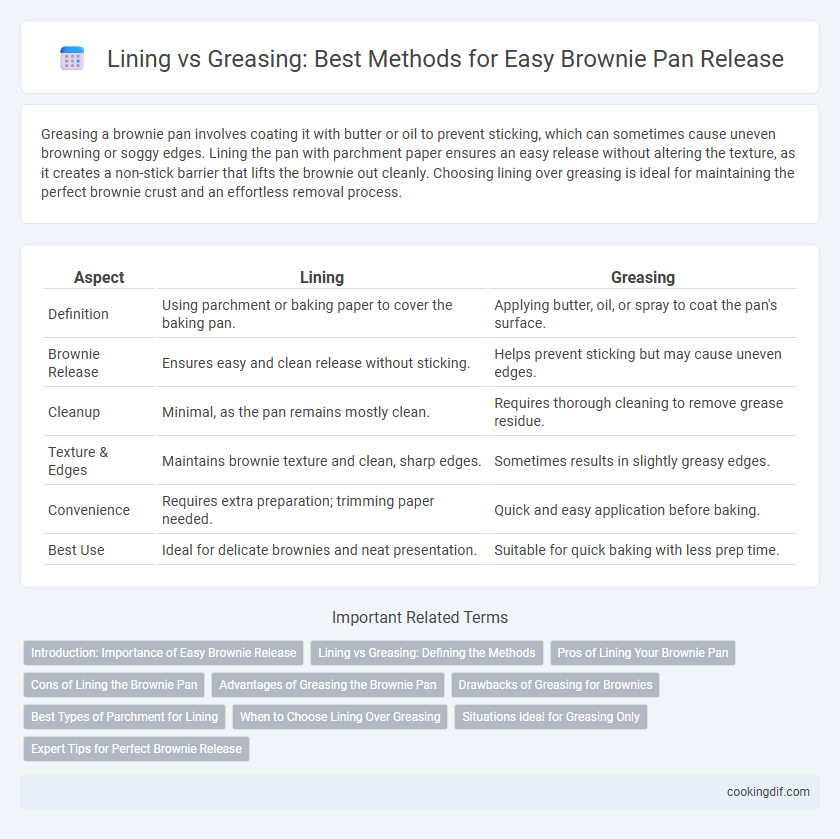Greasing a brownie pan involves coating it with butter or oil to prevent sticking, which can sometimes cause uneven browning or soggy edges. Lining the pan with parchment paper ensures an easy release without altering the texture, as it creates a non-stick barrier that lifts the brownie out cleanly. Choosing lining over greasing is ideal for maintaining the perfect brownie crust and an effortless removal process.
Table of Comparison
| Aspect | Lining | Greasing |
|---|---|---|
| Definition | Using parchment or baking paper to cover the baking pan. | Applying butter, oil, or spray to coat the pan's surface. |
| Brownie Release | Ensures easy and clean release without sticking. | Helps prevent sticking but may cause uneven edges. |
| Cleanup | Minimal, as the pan remains mostly clean. | Requires thorough cleaning to remove grease residue. |
| Texture & Edges | Maintains brownie texture and clean, sharp edges. | Sometimes results in slightly greasy edges. |
| Convenience | Requires extra preparation; trimming paper needed. | Quick and easy application before baking. |
| Best Use | Ideal for delicate brownies and neat presentation. | Suitable for quick baking with less prep time. |
Introduction: Importance of Easy Brownie Release
Ensuring easy brownie release from the pan is crucial for preserving the dessert's shape and texture while preventing crumbs from sticking. Proper lining with parchment paper creates a smooth, non-stick surface that allows brownies to lift out effortlessly, reducing the risk of cracks or tears. Greasing directly coats the pan with fat, aiding release but often less effectively than lining, especially with sticky or moist brownie batters.
Lining vs Greasing: Defining the Methods
Lining involves placing parchment or baking paper in the brownie pan to create a non-stick barrier, ensuring easy removal without affecting texture. Greasing uses butter or oil to coat the pan's surface, allowing brownies to release smoothly but sometimes altering the edges' crispness. Choosing between lining and greasing depends on the desired brownie texture and ease of release, with lining preferred for cleaner cuts and greasing favored for a slightly crispier crust.
Pros of Lining Your Brownie Pan
Lining your brownie pan with parchment paper ensures easy and clean release, preventing the brownies from sticking and maintaining their perfect shape. This method reduces the need for excess oils or sprays, promoting healthier baking and easier cleanup. Parchment lining also allows for lifting the entire batch out at once, simplifying portioning and presentation.
Cons of Lining the Brownie Pan
Lining a brownie pan with parchment paper can sometimes cause uneven edges, as the batter may stick to the parchment or fold unevenly, leading to inconsistent brownie shapes. There is also the risk of tearing the lining when removing the brownies, which can damage their texture and appearance. Furthermore, parchment paper lining adds an extra step to preparation and cleanup, potentially increasing overall baking time.
Advantages of Greasing the Brownie Pan
Greasing the brownie pan creates a thin, even barrier that prevents sticking and ensures easy release without tearing the edges. This method enhances the texture by allowing the brownies to develop a slightly crisp crust while maintaining a moist interior. Using butter or oil for greasing also adds subtle richness and improves the overall flavor of the baked brownies.
Drawbacks of Greasing for Brownies
Greasing a pan for brownies often causes uneven edges and a greasy bottom crust, impacting texture and presentation. The excess oil can also interfere with the brownie's crust formation, resulting in a less desirable chewiness. Unlike lining with parchment paper, greasing increases the risk of sticking in some spots while leaving others oily, making clean removal and serving more challenging.
Best Types of Parchment for Lining
For perfect brownie release, unbleached parchment paper with a silicone coating offers the best non-stick surface, preventing sticking while withstanding high temperatures up to 450degF. Greasing alone can alter the texture and introduce excess fat, whereas lining with high-quality parchment ensures even baking and easy removal. Investing in heavy-duty, non-stick parchment paper enhances brownie edges and preserves the rich, fudgy interior without residue or tearing.
When to Choose Lining Over Greasing
Lining a pan with parchment paper is preferred over greasing when brownies have a sticky, fudgy texture to ensure easy release without breaking. Lining allows lifting the entire brownie slab out of the pan, preserving clean edges and preventing crumbs. For thicker or denser brownie recipes, lining prevents excess oiliness and facilitates uniform cooling.
Situations Ideal for Greasing Only
Greasing the pan is ideal for sticky or fudgy brownie recipes that contain high sugar content, ensuring easy release without tearing. Metal or glass pans benefit most from greasing only, as this creates a thin barrier preventing sticking while maintaining the crust's texture. Avoid parchment paper when greasing only, as it adds unnecessary layers that alter baking time and texture.
Expert Tips for Perfect Brownie Release
Lining brownie pans with parchment paper ensures a smooth, clean release by preventing sticking and preserving edges, while greasing can sometimes cause uneven browning or sticking in dense brownies. Experts recommend cutting parchment to fit snugly with an overhang for easy lifting, combined with a light grease application to ensure even non-stick performance. For flawless brownie release, proper pan preparation with quality non-stick materials and precise measurements is essential to achieve perfect texture and presentation every time.
Lining vs Greasing for Brownie Release Infographic

 cookingdif.com
cookingdif.com